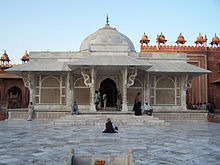印度伊斯兰教
外观
| 各国伊斯兰教 |
|---|
 |
|
|
| 印度穆斯林 | |
|---|---|
 | |
| 总人口 | |
| 2亿(2020年估计)[1] 占印度人口中约15% | |
| 分布地区 | |
| 印度各地,在查谟和克什米尔中央直辖区与拉克沙群岛中央直辖区为主要信仰,在全印度亦有大量信徒 | |
| 语言 | |
| 乌尔都语/印地语、孟加拉语、德干尼语、克什米尔语与其他印度语言 |
伊斯兰教在印度是信徒数量排名第二的宗教(仅次于印度教),2011年官方统计显示印度有1.72亿名穆斯林[2][3],至2020年印度的穆斯林人口估计已达2亿人[1],占印度总人口中约15%[4]。印度的穆斯林人数位列世界排名第三,只低过全国人口绝大多数为穆斯林的印尼和巴基斯坦两国[5]。伊斯兰教最早于七世纪由阿拉伯商人传至印度西岸的马拉巴尔海岸[6]、康坎与古吉拉特等地[7],喀拉拉邦的切拉曼主麻清真寺建于西元629年,被认为是印度的第一座清真寺[8][9]。1073年,法蒂玛王朝哈里发穆斯坦绥尔派遣使团到古吉拉特,将什叶派支派伊斯玛仪派传入[10]。十二世纪,突厥人入侵北印度时将伊斯兰教传入该地,使其成为印度文化的一部份[11]。数个世纪以来,印度伊斯兰教与印度教的文化互有相当程度的文化整合[12][13] ,穆斯林也在印度的社会、经济与政治等领域扮演重要角色[14]。
和其他宗教的冲突
[编辑]伊斯兰教传入次大陆后,和本地多神论的印度教冲突不断,从莫卧儿时代延续至今(因宰牛及反种姓的问题),2014年莫迪领导的印度人民党上台执政,在该党深厚的印度教背景下,更加剧了两教间的矛盾。[15]
各地区穆斯林人口
[编辑]


截至2015年[update],伊斯兰教在查谟-克什米尔邦与拉克沙群岛为多数信仰[17]。
各地统计
[编辑]2015年,穆斯林占印度唯一的查谟和克什米尔邦以及联盟领土拉克沙群岛的大部分人口。
印度各地区的穆斯林人口(2011年统计)[3][18][19]
| 地区 | 人口 | 穆斯林人口 | 占比例 |
|---|---|---|---|
| 印度 | 1,210,854,977 | 172,245,158 | 14.2% |
| 安达曼-尼科巴群岛 | 379,944 | 31,915 | 8.4% |
| 安得拉邦、特伦甘纳邦 | 84,580,777 | 8,128,661 | 9.6% |
| 阿鲁纳恰尔邦 | 1,382,611 | 27,652 | 2.0% |
| 阿萨姆邦 | 31,169,272 | 10,659,891 | 34.2% |
| 比哈尔邦 | 103,804,637 | 17,542,984 | 16.9% |
| 昌迪加尔 | 1,054,686 | 50,625 | 4.8% |
| 恰蒂斯加尔邦 | 25,540,196 | 510,804 | 2.0% |
| 达德拉-纳加尔哈维利 | 342,853 | 13,028 | 3.8% |
| 达曼-第乌 | 242,911 | 18,947 | 7.8% |
| 德里 | 16,753,235 | 2,161,167 | 12.9% |
| 果阿邦 | 1,457,723 | 122,449 | 8.4% |
| 古吉拉特邦 | 60,383,628 | 5,857,212 | 9.7% |
| 哈里亚纳邦 | 25,353,081 | 1,774,716 | 7.0% |
| 喜马偕尔邦 | 6,856,509 | 150,843 | 2.2% |
| 查谟-克什米尔邦 | 12,548,926 | 8,570,916 | 68.3% |
| 贾坎德邦 | 32,966,238 | 4,780,104 | 14.5% |
| 卡纳塔克邦 | 61,130,704 | 7,885,861 | 12.9% |
| 喀拉拉邦 | 33,387,677 | 8,881,122 | 26.6% |
| 拉克沙群岛 | 64,429 | 61,981 | 96.2% |
| 中央邦 | 72,597,565 | 4,791,439 | 6.6% |
| 马哈拉施特拉邦 | 112,372,972 | 12,922,892 | 11.5% |
| 曼尼普尔邦* | 2,721,756 | 228,627 | 8.4% |
| 梅加拉亚邦 | 2,964,007 | 130,416 | 4.4% |
| 米佐拉姆邦 | 1,091,014 | 15,274 | 1.4% |
| 那加兰邦 | 1,980,602 | 49,515 | 2.5% |
| 奥里萨邦 | 41,947,358 | 922,842 | 2.2% |
| 本地治里市 | 1,244,464 | 75,912 | 6.1% |
| 旁遮普邦 | 27,704,236 | 526,380 | 1.9% |
| 拉贾斯坦邦 | 68,621,012 | 6,244,512 | 9.1% |
| 锡金邦 | 607,688 | 9,723 | 1.6% |
| 泰米尔纳德邦 | 72,138,958 | 4,256,199 | 5.9% |
| 特里普拉邦 | 3,671,032 | 315,709 | 8.6% |
| 北方邦 | 199,581,477 | 38,519,225 | 19.3% |
| 北阿坎德邦 | 11,453,488[20] | 1,597,762 | 13.95%[21] |
| 西孟加拉邦 | 98,785,114[20] | 27,165,906 | 27.5%[22] |
参考文献
[编辑]- ^ 1.0 1.1 存档副本. [2023-10-04]. (原始内容存档于2023-10-05).
- ^ Religion Data - Population of Hindu / Muslim / Sikh / Christian - Census 2011 India. www.census2011.co.in. [2017-07-28]. (原始内容存档于2017-07-11).
- ^ 3.0 3.1 Muslim population growth slows. The Hindu. [2017-07-28]. (原始内容存档于2017-07-03) (英语).
- ^ 存档副本. [2023-10-04]. (原始内容存档于2023-05-23).
- ^ 存档副本. [2023-10-04]. (原始内容存档于2023-10-05).
- ^ 'Trade, not invasion brought Islam to India' - Times of India. The Times of India. [2017-07-28]. (原始内容存档于2017-05-05).
- ^ Wink, André. Al-Hind, the making of the Indo-Islamic world 2. ed., amended. Leiden: E.J. Brill. 1990: 68 [29 January 2014]. ISBN 9004092498. (原始内容存档于2016-01-09).
Up to about the tenth century the largest settlement of Arabs and Persian Muslim traders are not found in Malabar however but rather more to the north in coastal towns of the Konkan and Gujarat, where in pre-Islamic times the Persians dominated the trade with the west. Here the main impetus to Muslim settlement came from the merchants of the Persian Gulf and Oman, with a minority from Hadramaut.
- ^ Cheraman Juma Masjid: A 1,000-year-old lamp burns in this mosque - Times of India. The Times of India. [2017-07-28]. (原始内容存档于2017-08-07).
- ^ PM Narendra Modi likely to visit India's oldest mosque during Kerala trip - Times of India. The Times of India. [2017-07-28]. (原始内容存档于2016-10-25).
- ^ [1]; p.33; ‘act of al Mustansir was sending missionaries to Gujarat’, Jonah Blank, University of Chicago
- ^ Sharma, Suresh K.; Sharma, Usha. Cultural and Religious Heritage of India: Islam. Mittal Publications. 2004. ISBN 9788170999607 (英语).
- ^ Dunn, Ross E. The Adventures of Ibn Battuta: A Muslim Traveler of the Fourteenth Century. University of California Press. 2004-12-09 [2018-12-01]. ISBN 9780520931718. (原始内容存档于2017-06-29) (英语).
- ^ Tharoor, Shashi. India: From Midnight to the Millennium and Beyond. Arcade Publishing. 2006 [2018-12-01]. ISBN 9781559708036. (原始内容存档于2016-10-12) (英语).
- ^ Madani, Mohsen Saeidi. Impact of Hindu Culture on Muslims. M.D. Publications Pvt. Ltd. 1993: 1. ISBN 9788185880150 (英语).
- ^ Hindu Mobs in India Attack Muslims, Loot Businesses and Destroy Mosques. Albawaba.
- ^ Population by religious communities Census of India (页面存档备份,存于互联网档案馆), Ministry of Home Affairs, Govt of India
- ^ Religious communities Census 2011: What the numbers say. The Hindu. [26 April 2016]. (原始内容存档于2016-01-10).
- ^ Why India’s Muslims are so moderate. Economist. 7 September 2014 [2018-12-01]. (原始内容存档于2017-08-01).
- ^ Muslim population grows marginally faster: Census 2011 data. www.hindustantimes.com. 2015-08-25 [2017-07-28]. (原始内容存档于2017-07-27) (英语).
- ^ 20.0 20.1 Census of India Website : Office of the Registrar General & Census Commissioner, India. censusindia.gov.in. [2020-01-04]. (原始内容存档于2020-01-14).
- ^ Uttarakhand Religion Data – Census 2011. www.census2011.co.in. [2019-03-03]. (原始内容存档于2021-02-04).
- ^ West Bengal (PDF). (原始内容存档 (PDF)于2019-07-12).

